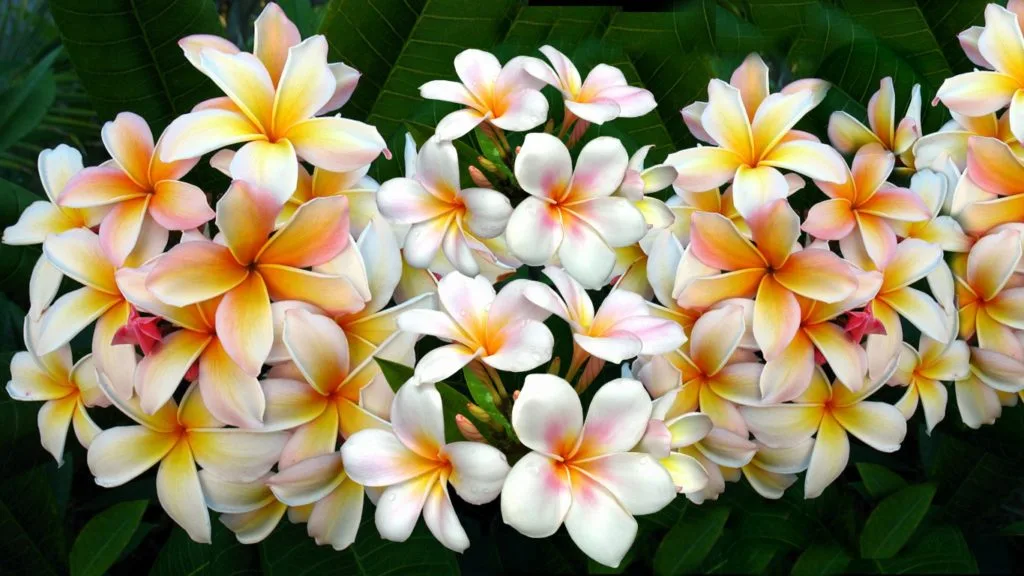index
Introduction to Frangipani
Frangipani, also known as Frangipani, is an exuberant plant with fragrant flowers. Native to tropical regions, its flowers come in a variety of colors, including shades of white, yellow, pink and red. Commonly cultivated for its ornamental beauty, Frangipani is popular in gardens, reaching considerable heights and transforming landscapes with its vibrant presence.
Meaning of Frangipani
Frangipani is associated with several symbolic meanings, including:
- Beauty and Charm: Its dazzling flowers represent beauty and charm.
- Afterlife: In some cultures, it is seen as a symbol of life after death.
- Love and Relationships: The flowers can also represent love and lasting connection.
Growing Frangipani not only adds a tropical touch to the environment, but can also evoke deep symbolic feelings.
| Common Name | Frangipani |
|---|---|
| Botanical Name | Plumeria spp. |
| Family | Apocynaceae |
| Plant Type | Shrub or Tree |
| Adult Size | Up to 8 meters high |
| Sun Exposure | Full sun |
| Soil type | Well-drained, sandy |
| soil pH | Slightly acidic to neutral (6.0-7.0) |
| Flowering Season | Spring and summer |
| Flower color | White, Yellow, Pink, Red |
| Native Area | Central America, South America |
| Toxicity | Toxic to pets |
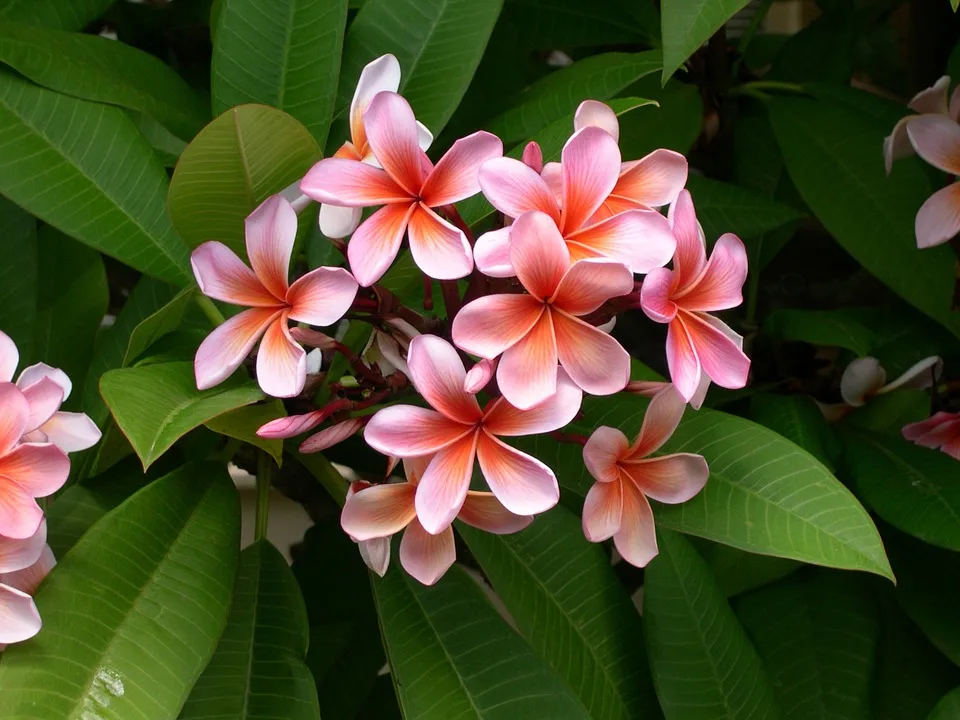
How to care for Frangipani
Frangipani, known for its lush flowers and enchanting fragrance, requires specific care to fully thrive. Let’s explore in detail the recommended practices to ensure the healthy flowering of this unique plant.
Light
Frangipani is a sun lover. As such, it is crucial to provide a sunny environment to allow it to develop optimally. Places that receive at least six hours of direct sunlight daily are ideal. Make sure you choose a well-lit area to plant your Frangipani.
Soil
The choice of soil plays a vital role in the successful cultivation of Frangipani. Opt for well-drained and aerated soil to prevent water from accumulating in the roots. This helps prevent problems such as root rot and ensures an environment conducive to healthy growth.
Water
Proper water management is essential for caring for Frangipani. Water the plant moderately, allowing the soil to dry out between waterings. Avoid overwatering, as prolonged accumulation can result in conditions favorable to the development of moisture-related diseases.
Temperature and humidity
Frangipani thrives in warm climates and does not tolerate temperatures below 10°C. It is therefore essential to provide a suitable thermal environment for its growth. In addition, although it is resistant to humidity, avoid excessively humid environments.
Fertilization
Proper fertilization is a crucial component of caring for Frangipani. During the growing season, apply a balanced fertilizer to encourage vibrant flowering. Reduce the frequency of fertilization during the winter, respecting the plant’s natural growth cycle.
By following these guidelines, you will be providing the ideal conditions for your Frangipani to develop robustly, rewarding you with its magnificent flowers and enveloping perfume.
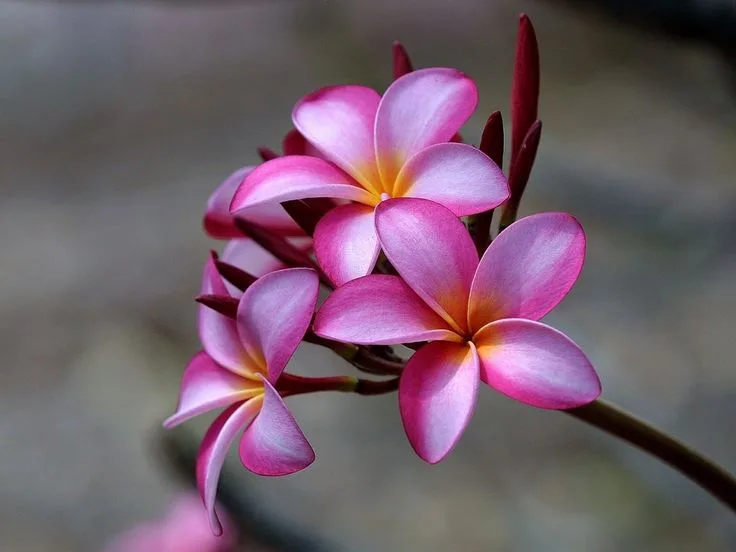
Types of Frangipani
Frangipani, known for its beauty and fragrance, comes in a variety of types that delight plant lovers. Let’s explore some remarkable varieties of this fascinating plant:
1. Frangipani rubra
- Characteristics: It has vibrant flowers in shades of red, pink and white.
- Highlight: Widely cultivated classic variety.
2. Frangipani obtusa
- Characteristics: Smaller flowers and narrower leaves.
- Highlight: Known as “Frangipani Singapur.”
3. Frangipani pudica
- Characteristics: Distinguished by its elongated leaves and white flowers.
- Noteworthy: Popularly known as “Frangipani Cingapuram.”
4. Frangipani alba
- Characteristics: Medium to large white flowers.
- Noteworthy: Also known as “White Frangipani.”
5. Frangipani stenopetala
- Characteristics: Flowers with narrower petals.
- Highlight: Unique and elegant variety.
6. Frangipani pudica x Frangipani rubra
- Characteristics: Hybridization between two varieties, resulting in unique characteristics.
- Highlight: Combining the best of both varieties.
These are just a few examples of the rich variety of Frangipani available. By choosing between these types, plant lovers have the opportunity to add a unique and colorful dimension to their garden or green space.
How to make Frangipani Seedlings
Materials needed:
- Frangipani cuttings: Choose healthy cuttings, preferably about 30 cm long.
- Rooting Substrate: Use a light, well-drained substrate.
Steps:
- Choosing cuttings: Opt for cuttings that don’t have flowers, choosing those with active growth.
- Cutting: Make diagonal cuts in the cuttings, removing flowers and leaves.
- Drying: Let the cuttings dry in the open air for a few days to heal.
- Planting: Insert the cuttings into the substrate, making sure they are buried deep enough to support the plant.
- Watering: Keep the substrate moist, not soaked, to promote rooting.
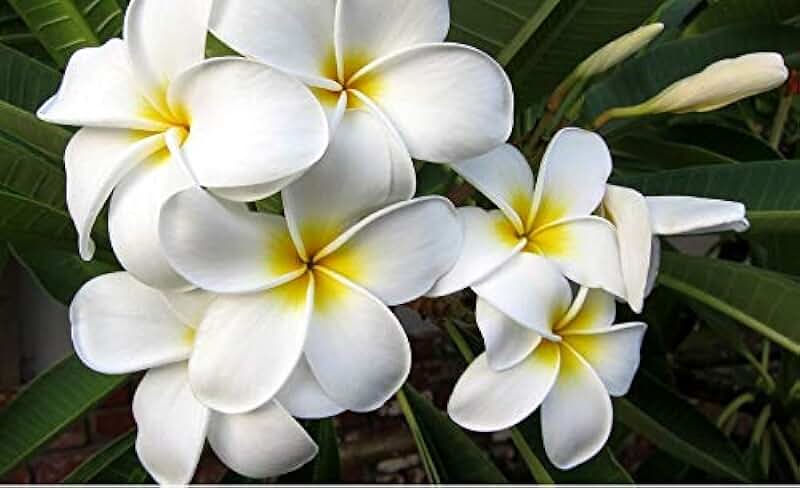
How to Plant Frangipani in the Garden or Pot
Planting in the garden:
- Choosing a location: Choose a spot with at least six hours of direct sunlight.
- Soil Preparation: Make sure the soil is well-drained and enriched with organic matter.
- Spacing: Plant the Frangipani, leaving adequate space between each plant.
- Initial watering: After planting, carry out a generous initial watering.
Planting in a pot:
- Pot selection: Choose a pot large enough to accommodate the Frangipani’s root system.
- Substrate: Use a substrate for tropical plants, ensuring good drainage.
- Positioning: Place the Frangipani so that it receives direct sunlight.
- Watering and drainage: Water moderately and make sure the pot has good drainage.
By following these guidelines, you’ll be well on your way to successfully propagating and planting Frangipani’s, providing a garden or outdoor space full of beauty and perfume.
Common pests and diseases
Frangipani, despite its exuberant beauty, can face challenges related to pests and diseases. Watch out for the signs and learn how to deal with these problems.
Pests:
- Mites: Detected by leaves with yellow spots and fine webs.
- Solution: Use predatory mites or apply neem oil.
- Mealybugs: Identified by small white dots on the leaves.
- Solution: Remove by hand or use insecticidal soap.
- Whitefly: Visible when the plant is disturbed, causing weakening.
- Solution: Use sticky traps or insecticidal soap.
Diseases:
- Leaf spot: Marked by yellow or brown spots on the leaves.
- Solution: Remove the affected leaves and avoid wetting them when watering.
- Root rot: Manifested by dark, smelly roots.
- Solution: Transplant the plant to well-drained soil and reduce watering.
- Mildew: Indicated by white powdery spots on the leaves.
- Solution: Treat with appropriate fungicides.
- Virus: Evidenced by leaf deformities and abnormal color patterns.
- Solution: Eliminate affected plants to prevent spread.
By promptly identifying and treating these problems, you will ensure that your Frangipani thrive, maintaining their exuberance and vitality. Always remember to apply preventative measures to preserve the plant’s overall health.
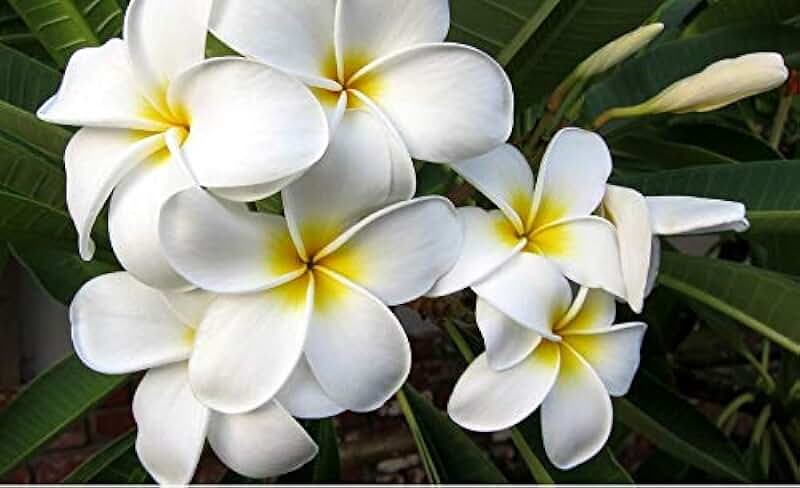
Curiosities and myths
Discover intriguing facts and debunk beliefs about the enchanting Frangipani, also known as frangipani.
Curiosities about Frangipani:
- Variety of Colors: Frangipani are not limited to white. They can have shades of pink, yellow, red and even multiple colors in a single flower.
- Unique Fragrance: The flowers exude a sweet, enveloping fragrance, especially at night, attracting moths and nocturnal pollinators.
- Cultural Symbolism: In some cultures, such as Hawaii, Frangipani symbolizes beauty, love and the bond between people.
- Climate Adaptation: Known for their resilience, Frangipani thrive in warm climates and can withstand harsh conditions.
- Longevity: These plants can live for decades, providing lasting beauty in gardens and landscapes.
Common Myths About Frangipani:
- Toxic to Animals: Although some parts are toxic, Frangipaniis not highly poisonous to pets.
- Demanding in Care: Despite their delicate appearance, Frangipani are robust and don’t require overly complicated care.
- For Tropical Climates Only: With proper care, it is possible to grow Frangipani in colder climates, as long as they are protected from the intense cold.
- For Large Gardens Only: Frangipani can adapt to pots, making them ideal for balconies and smaller spaces.
By uncovering these curiosities and debunking myths, you’ll appreciate the beauty and versatility of Frangipani even more in your gardening projects.
Conclusion
We end this journey through the fascinating Frangipani with a renewed appreciation for this enchanting plant.
Lasting Beauty and Cultural Symbolism: Frangipani, with its lush flowers and variety of colors, offers lasting beauty in gardens and landscapes. In addition, its cultural symbolism, especially in Hawaii, adds a special layer of meaning to this remarkable plant.
Debunking Myths and Appreciating Its Unique Characteristics: As we explore curiosities and debunk myths, we realize that Frangipani is more than its graceful appearance. Its adaptation to different environments and less demanding care make it an affordable and rewarding choice for plant enthusiasts.
We invite you to celebrate botanical diversity by incorporating Frangipani into your spaces, where its beauty and symbolism can flourish, providing a unique visual and sensory experience. May the exuberance of Frangipani continue to inspire your passion for gardening.
Frequently Asked Questions
How to take care of a Frangipani?
Caring for a Frangipani involves paying attention to several aspects to ensure its healthy flowering:
Light: Prefers direct sunlight.
Soil: Well-drained, aerated and rich in organic matter.
Water: Moderate watering, avoiding waterlogging.
Temperature: A warm climate is ideal.
Fertilization: Balanced fertilizers during the growing season.
What does the Frangipani flower mean?
Frangipani is a symbol of:
Beauty and Charm: It represents exuberant tropical beauty.
New Life: Associated with rebirth due to its ability to regrow after pruning.
Love and Devotion: Used in necklaces in Hawaii to express affectionate feelings.
What is Frangipani used for?
In addition to its ornamental beauty, Frangipani has practical uses:
Perfumes: Extracts from the flowers are used in the production of perfumes.
Cultural traditions: In Hawaii, the flowers are used in rituals and to make necklaces.
Traditional medicine: Some cultures use parts of the plant for medicinal treatments.


